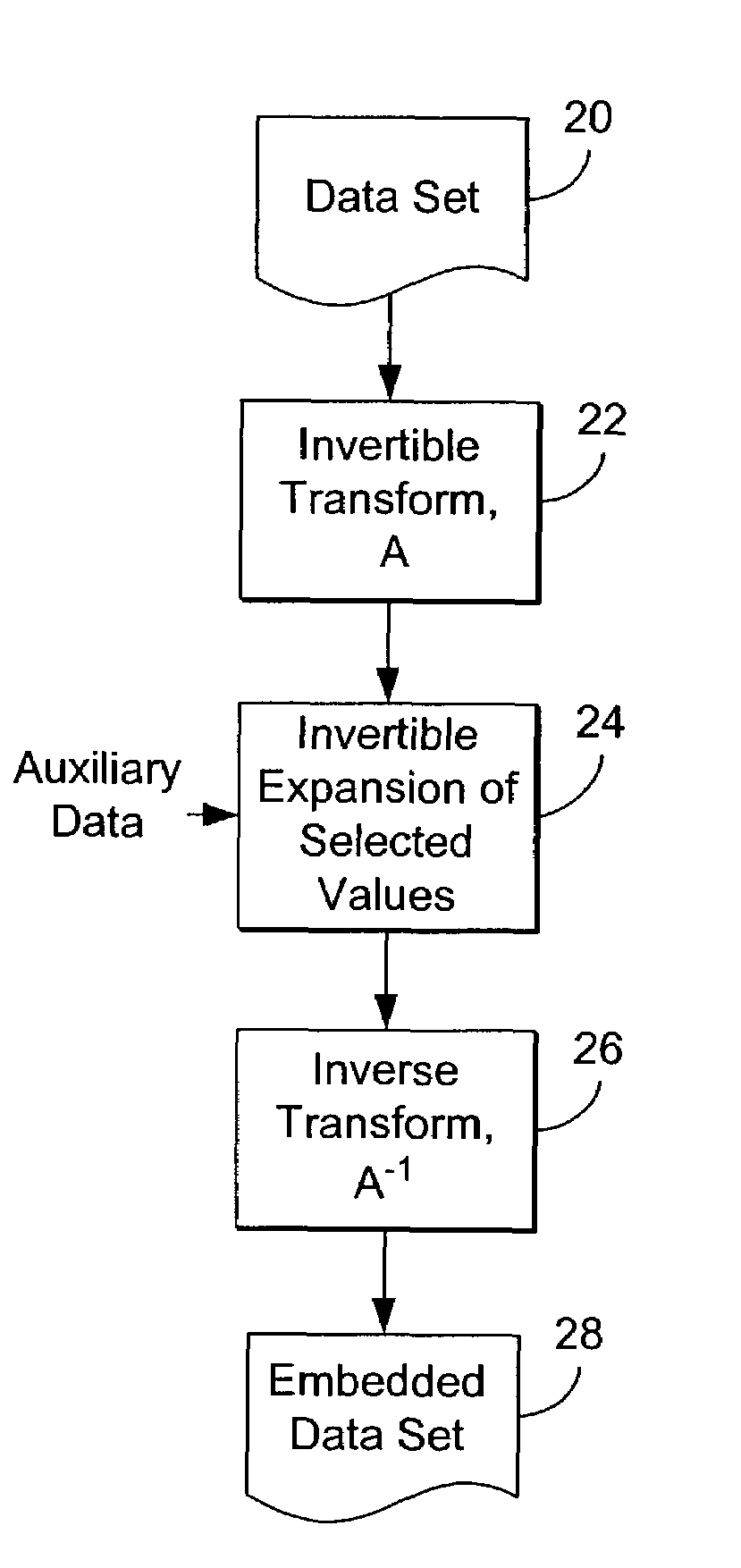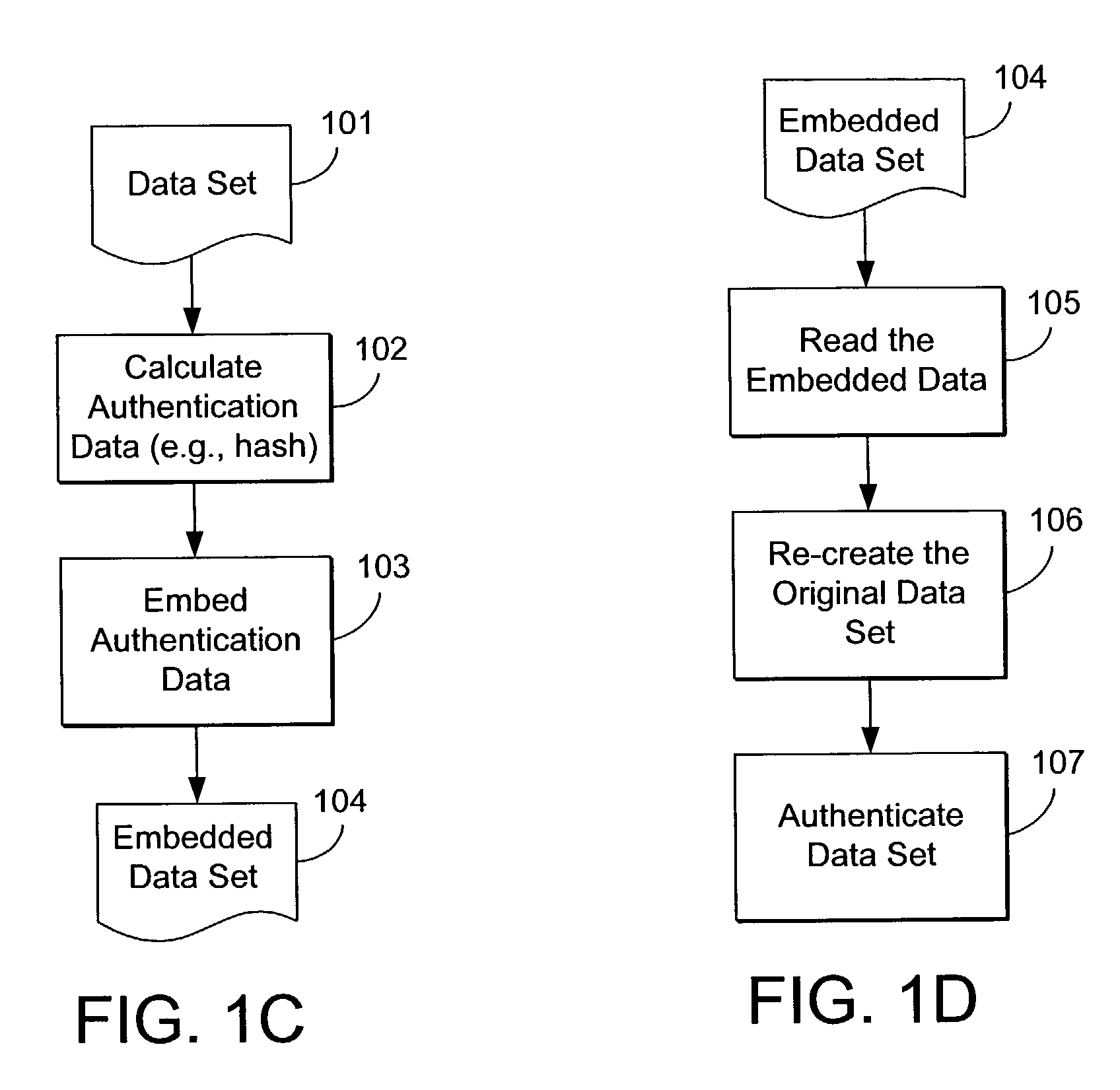Reversible watermarking
a watermarking and reverse technology, applied in the field of steganography, can solve the problems of watermark degraded or rendered unreadable, overflow or underflow conditions, and watermark is rendered unreadable or degraded in a predictable fashion
- Summary
- Abstract
- Description
- Claims
- Application Information
AI Technical Summary
Benefits of technology
Problems solved by technology
Method used
Image
Examples
second embodiment
Detail of Second Embodiment
[0217]The following is a detailed explanation of a second embodiment of the invention. This embodiment involves a reversible data embedding method for digital images. However, the method can be applied to digital audio and video as well. This embodiment is an example of expansion using N states for auxiliary data values to be embedded, where the state N corresponds to the level number L.
[0218]In this embodiment, two mathematical techniques are utilized, namely, difference expansion and Generalized Least Significant Bit (G-LSB) embedding. This embodiment achieves a very high embedding capacity, while keeping the distortion low.
[0219]In this embodiment, as in the first embodiment, the differences of neighboring pixel values are calculated, and some difference numbers are selected for difference expansion. The original G-LSBs values of the difference numbers, the location of expanded difference numbers, and a payload (which includes an authentication hash of ...
third embodiment
[0292]The third embodiment uses the same reversible integer transform as used in the first and second embodiment and which is given by equations 1, 21, 2 and 22 above. Furthermore to prevent overflow and underflow conditions:
[0293]0≤l+⌊h+12⌋≤255,and0≤l-⌊h2⌋≤255
since l and h are integers, the above is equivalent to:
[0294]h′≤2(255-l),andh≤2l+1(33)
[0295]Condition (33) sets a limit on the magnitude (absolute value) of the difference number h. As long as h is in such range, it is guaranteed that (x, y) computed from Equation 2 or 22 will be a grayscale value. Condition given by equations 33 above are equivalent to:
[0296]h′≤2(255-l),if128≤l≤255h≤2l+1,if0≤l≤127
[0297]For this embodiment Expandable and Changeable difference numbers are defined as follows: When a bit b is embedded into a difference number h by difference expansion, the new difference number h′ is:
h′=2×h+b
[0298]In accordance with equation 33 above, in order to prevent overflow and underflow, h′ must satisfy the fol...
fourth embodiment
[0383]This embodiment provides a reversible watermarking method of digital images. While the embodiment specifically applies the method to a digital image, the method can be applied to digital audio and video as well. This embodiment employs an integer wavelet transform to losslessly remove redundancy in a digital image to allocate space for watermark embedding. The embedding algorithm starts with a reversible color conversion transform. Then, it applies the integer wavelet transform to one (or more) de-correlated component(s). The purpose of both the reversible color conversion transform and the integer wavelet transform is to remove irregular redundancy in the digital image, such that we can embed regular redundancy into the digital image, for the purpose of content authentication and original content recovery. The regular redundancy could be a hash of the image, a compressed bit stream of the image, or some other image content dependent watermark. In the integer wavelet domain, w...
PUM
 Login to View More
Login to View More Abstract
Description
Claims
Application Information
 Login to View More
Login to View More - R&D
- Intellectual Property
- Life Sciences
- Materials
- Tech Scout
- Unparalleled Data Quality
- Higher Quality Content
- 60% Fewer Hallucinations
Browse by: Latest US Patents, China's latest patents, Technical Efficacy Thesaurus, Application Domain, Technology Topic, Popular Technical Reports.
© 2025 PatSnap. All rights reserved.Legal|Privacy policy|Modern Slavery Act Transparency Statement|Sitemap|About US| Contact US: help@patsnap.com



